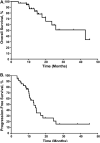Stereotactic body radiation therapy for patients with lung cancer previously treated with thoracic radiation
- PMID: 20381271
- PMCID: PMC3401019
- DOI: 10.1016/j.ijrobp.2009.09.070
Stereotactic body radiation therapy for patients with lung cancer previously treated with thoracic radiation
Abstract
Purpose: Stereotactic body radiation therapy (SBRT) provides excellent local control with acceptable toxicity for patients with early-stage non-small cell lung cancer. However, the efficacy and safety of SBRT for patients previously given thoracic radiation therapy is not known. In this study, we retrospectively reviewed outcomes after SBRT for recurrent disease among patients previously given radiation therapy to the chest.
Materials and methods: A search of medical records for patients treated with SBRT to the thorax after prior fractionated radiation therapy to the chest at The University of Texas M. D. Anderson Cancer Center revealed 36 such cases. The median follow-up time after SBRT was 15 months. The endpoints analyzed were overall survival, local control, and the incidence and severity of treatment-related toxicity.
Results: SBRT provided in-field local control for 92% of patients; at 2 years, the actuarial overall survival rate was 59%, and the actuarial progression-free survival rate was 26%, with the primary site of failure being intrathoracic relapse. Fifty percent of patients experienced worsening of dyspnea after SBRT, with 19% requiring oxygen supplementation; 30% of patients experienced chest wall pain and 8% Grade 3 esophagitis. No Grade 4 or 5 toxic effects were noted.
Conclusions: SBRT can provide excellent in-field tumor control in patients who have received prior radiation therapy. Toxicity was significant but manageable. The high rate of intrathoracic failure indicates the need for further study to identify patients who would derive the most benefit from SBRT for this purpose.
Copyright © 2010 Elsevier Inc. All rights reserved.
Figures




References
-
- Blackstock AW, Govindan R. Definitive chemoradiation for the treatment of locally advanced non small-cell lung cancer. J Clin Oncol. 2007;25:4146–4152. - PubMed
-
- Johnson BE. Second lung cancers in patients after treatment for an initial lung cancer. J Natl Cancer Inst. 1998;90:1335–1345. - PubMed
-
- Jeremic B, Shibamoto Y, Acimovic L, et al. Second cancers occurring in patients with early stage non-small-cell lung cancer treated with chest radiation therapy alone. J Clin Oncol. 2001;19:1056–1063. - PubMed
-
- Bauman JE, Mulligan MS, Martins RG, et al. Salvage lung resection after definitive radiation (>59 Gy) for non–small cell lung cancer: Surgical and oncologic outcomes. Ann Thorac Surg. 2008;86:1632–1638. discussion 1638–1639. - PubMed
-
- Noble J, Ellis PM, Mackay JA, et al. Second-line or subsequent systemic therapy for recurrent or progressive non-small cell lung cancer: A systematic review and practice guideline. J Thorac Oncol. 2006;1:1042–1058. - PubMed
Publication types
MeSH terms
Grants and funding
LinkOut - more resources
Full Text Sources
Medical

